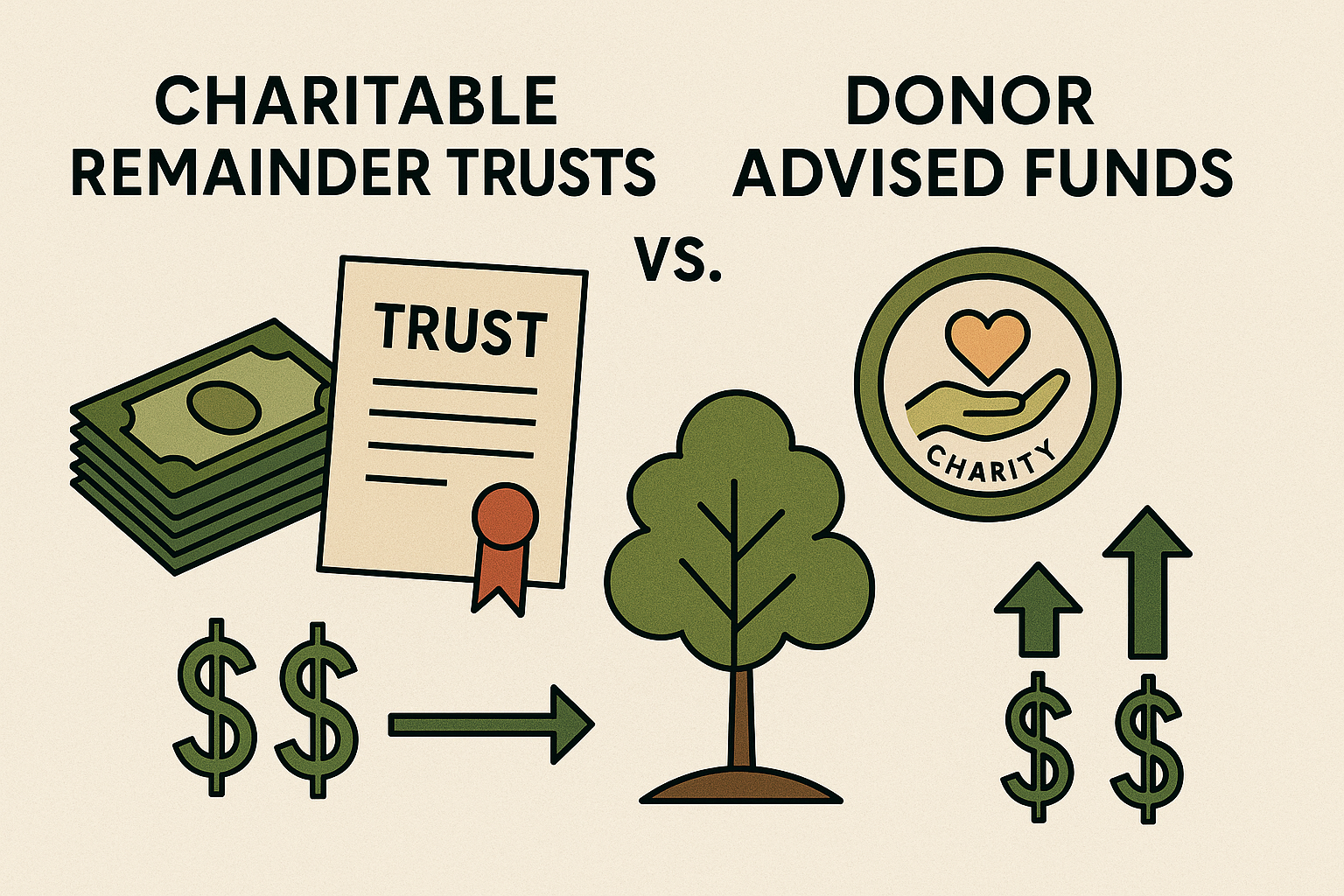When it comes to planned giving, the options can feel overwhelming. Two of the most powerful tools are the Charitable Remainder Trust (CRT) and the Donor Advised Fund (DAF). Both offer big advantages if you want to make a difference while managing taxes and legacy plans. The right choice depends on your goals, your timeline, and how much control you want over the process.
What is a Charitable Remainder Trust (CRT)?
A Charitable Remainder Trust is a legal structure that provides you or your beneficiaries with income for life or a set number of years. Once the income term ends, whatever is left goes to a charity you select. CRTs are popular because they allow you to turn appreciated assets into income, avoid immediate capital gains taxes, and receive a partial income tax deduction.
There are two main types of CRTs:
-
Charitable Remainder Unitrusts (CRUTs): Pay a set percentage of the trust’s value, recalculated each year.
-
Charitable Remainder Annuity Trusts (CRATs): Pay a fixed dollar amount each year, regardless of trust value changes.
In both cases, you can diversify your investments, create a steady income stream, and support a cause close to your heart.
What is a Donor Advised Fund (DAF)?
A Donor Advised Fund is like a charitable investment account. You contribute assets, receive an immediate tax deduction, and then recommend grants to charities over time. You do not get income back from a DAF, but you do maintain advisory privileges to decide when and where donations are made.
DAFs are popular because they are easy to set up, flexible, and require less maintenance than a CRT. Most financial institutions and community foundations offer DAF services.
In short, a DAF is a way to make a charitable impact without locking in a specific charity right away or committing to complicated trust arrangements.
Key Differences Between CRTs and DAFs
Choosing between a CRT and a DAF comes down to a few important factors:
Income Stream
-
CRT: Provides income for you or your beneficiaries.
-
DAF: Does not provide any income back to you.
Timing of Gifts
-
CRT: The charity receives the gift only after the trust term ends.
-
DAF: You can make grants to charities immediately or over many years.
Tax Benefits
-
CRT: Partial income tax deduction, plus avoidance of capital gains on donated appreciated assets.
-
DAF: Full immediate deduction for the amount contributed, subject to IRS limits.
Control and Flexibility
-
CRT: Fixed structure once set up. Charity is often specified early but may have flexibility if structured carefully.
-
DAF: Complete flexibility to choose different charities over time, add family advisors, or shift giving strategies.
Setup and Administration
-
CRT: Requires attorneys, tax advisors, and annual trust administration.
-
DAF: Simple setup through a sponsoring organization with minimal paperwork.
Costs
-
CRT: Higher setup and annual administration fees.
-
DAF: Typically low or no setup fee, small annual maintenance fee.
When a Charitable Remainder Trust Makes More Sense
A CRT may be the better fit if you:
-
Need lifetime income as part of your retirement or estate plan
-
Own highly appreciated assets and want to avoid immediate capital gains
-
Are ready to commit to a structured giving plan
-
Want to provide for family members before a final charitable gift is made
A CRT is especially useful if you are selling a business, real estate, or stocks and want to avoid triggering major taxes while planning for future philanthropy.
When a Donor Advised Fund Might Be Better
A DAF is a great choice if you:
-
Do not need income back
-
Want a simple, flexible tool for ongoing charitable giving
-
Prefer to change your charitable focus over time
-
Are looking for an easy way to involve family members in philanthropy
DAFs are ideal for donors who want to make a tax-deductible gift now and decide later how the funds should be used.
Can You Use Both a CRT and a DAF?
Absolutely. Some people set up a CRT to provide income and avoid taxes, then name a DAF as the final charitable beneficiary. This strategy can give your family flexibility to recommend grants from the DAF after your lifetime, allowing your legacy to continue in a more personal way.
Using both tools together can create a powerful planned giving structure that balances income needs, tax efficiency, and family engagement.
Final Thoughts
Charitable Remainder Trusts and Donor Advised Funds both have a place in thoughtful estate and philanthropic planning. The right choice depends on whether you need income, how much control you want over charitable decisions, and how complex you are willing to get.
No matter which option you choose, you are taking an important step toward building a legacy that reflects your values and supports the causes that matter most.
Key Takeaways
-
A Charitable Remainder Trust (CRT) provides income during your lifetime and leaves a gift to charity later.
-
A Donor Advised Fund (DAF) offers immediate tax benefits and flexible charitable giving without income back to you.
-
CRTs help avoid capital gains taxes on appreciated assets, but require more setup and administration.
-
DAFs are simple, low-cost, and great for flexible or evolving philanthropic plans.
-
You can combine a CRT and DAF for a customized giving strategy that balances income, tax savings, and family involvement.
If you have feedback, questions, or ideas for future articles or Information Hubs, please contact us. Your insights help us create valuable content.


